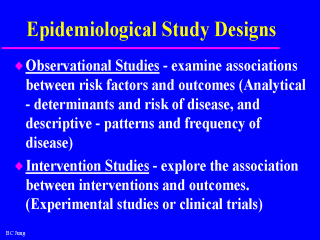| front |1 |2 |3 |4 |5 |6 |7 |8 |9 |10 |11 |12 |13 |14 |15 |16 |17 |18 |19 |20 |21 |22 |23 |24 |review |
 |
Similar to how Research is
viewed in general, there is no clear typology to epidemiological study designs. This has
made it difficult to explain these studies in a simple way. It can be said, in general, that there are two main types of studies. Observational studies are those in which the researchers do not interfere or manipulate any of the factors under study. They record their observations of whatís going on, and explain what they observe with measures of associations While we would like to say that A causes B, in order for these kinds of studies to attempt such an explanation, there would have to be many, many studies that observed the same chain of events before there is a consensus that A causes B, if that. Interventional studies are when researchers attempt to show that A causes B by actually manipulating those factors they think have something to do with causing some outcome. These usually look at how well some treatment work. In Public Health, itís difficult to show that a specific factor caused a particular outcome, when we are talking about populations. There are usually many factors that can result in a particular outcome. And because it is unethical to conduct testing on human subjects without peopleís consent, conducting research involving general populations is infeasible as well. So, from a feasibility standpoint, observational studies are more common, and if done well, can provide us with insights on how to control disease and improve quality of life. |